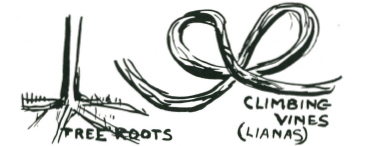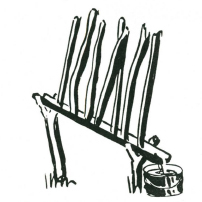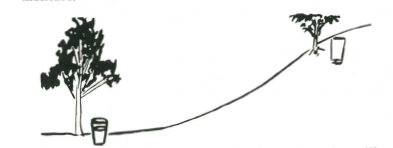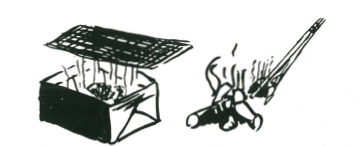REPTILES
Most of the land-living reptiles are independent, to a very large extent, on water. They get what they require from dew and the flesh of their prey, and as a result are not an indicator of water in the area.
WATER FROM VEGETABLE SOURCES

The roots and branches of many trees contain sufficient free-flowing fluid to relieve thirst, and this can be collected by breaking into 3 ft. lengths the roots or branches and standing these in a trough (of bark) into which the collected fluid will drain to the pannikin. In some plants the amount of water stored is truly unbelievable, the fluid literally gushing out when the plant is cut.

These vegetable “drinking waters” cannot be kept for more than twenty-four hours. The fluid starts to ferment or go bad if stored, and might be dangerous to drink if in this condition.
The nature of the plant, if judged by the properties of its foliage, is no guide to the drinkability of the fluids which are its sap. For example, the eucalypts, whose leaves are heavily impregnated with oils of eucalyptus, and in many cases poisonous to human beings, contain a drinkable fluid, easily collected (from the branches or roots). This fluid is entirely free from the essential oils and with no taint of the eucalyptus.
The lianas or monkey ropes found in tropical areas are an example of a prolific source of water.
There are certain precautions, and a few danger signs, with regard to vegetable fluids. If the fluid is milky or coloured in any way, it should be regarded as dangerous, not only to drink but also to the skin. Many of the milky saps, except those of the ficus family, which contain latex, or a natural rubber, are extremely poisonous. The milky sap of many weeds can poison the skin and form bad sores, and if allowed to get into the eye may cause blindness and severe pain.
With all vegetable sources of fluid even though the water itself is clear, taste it first and, if quite, or almost, flavourless, it is safe to drink.
For vegetable sources of water in arid areas the best volume is generally obtained by scratching up the surface roots. They are discovered close to the ground, and if cut close to the tree, may be lifted and pulled, each root yielding a length of from ten to twenty feet. These must be cut into shorter lengths for draining.
Many people who have tried to obtain drinking water from vegetable sources failed to get the precious liquid to flow because they did not break or cut the stalk or root into lengths. Unless these breaks are made, the fluid cannot flow, and the conclusion is that the root, branch or vine is without moisture.

In general, water is more plentiful from plants in gullies than on ridges, and the flow is wasted if the roots are broken into sections and not cut. Cutting tends to bruise and seal the capillary channels.
DEW COLLECTION
In barren areas where there are no trees, it may be possible to collect sufficient moisture from the grass in the form of dew, to preserve life. One of the easiest ways of dew collection is to tie rags or tufts of fine grass round the ankles and walk through the herbage before the sun has risen, saueezing the moisture collected by the tufts or rags into a container. Many early explorers saved their lives by this simple expedient.
Pig Face (Mesembryanthemum) and Ice Plant (Parakylia) and Pig Weed contain large proportions of drinkable moisture.
WATER ON THE SEA COAST

Fresh water can always be found along the sea coast by digging behind the wind-blown sandhills which back most ocean beaches. These sandhills trap rain water, and it floats on top of the heavier salt water which filters in from the ocean. Sandhill wells must be only deep enough to uncover the top inch or two of water. If dug deeper, salt water will be encountered and the water from the well may be brackish and undrinkable. It will be noticed, too, that the water in these wells rises and falls slightly with the tides.
These sand wells are a completely reliable source of water all over the world. When digging it is necessary to revet the sides with brushwood, otherwise the sand will fall into the well.

On coastal areas where cliffs fall into a sea a careful search along the lower edges of the cliff will generally disclose soaks or small springs. These in general follow a fault in the rock formation and frequently are evident by a lush growth of ferns and mosses.
MOISTURE FROM FISH FLESH

Another source of liquid sufficient to sustain life at sea, when fresh water has ceased to be available, is from the flesh of fish. The fish are diced, and the small portions of flesh placed in a piece of cotton cloth and the moisture wrung out. This moisture from sea fish is not in itself excessively salty, and can sustain life for a long period.
CONDENSING SALT WATER
It is possible to condense sea water without equipment and obtain sufficient fresh water for drinking purposes. (See moisture condensation overleaf.)

A coolamon is made, or alternatively a hole is scraped in the ground and lined, and the salt water is put into this hole. A fire is built, and stones are put in the fire to heat. These when hot are put in the salt water, which soon boils, and the water vapour is soaked up by a towel or thick mat of cloth. In time, this will literally become saturated, and may be wrung out, yielding a fair quantity of fresh drinkable water. Once the cloth is damp and cool, the collection of water vapour is fairly rapid.
MOISTURE CONDENSATION IN ARID AREAS
A simple still for water condensation in arid areas can be made from a piece of light plastic sheeting, about 4 ft. square.
A hole is dug or scooped in the ground in a sunny position. The hole should be about 3 ft. across and 15” to 18” deep or deeper if possible.
The site should preferably be in moist ground, a depression in a creek bed is ideal if one can be found. If green material such as shrubs or succulent herbage is in the vicinity, the hole should be lined with this and the material packed down. It may be necessary to weigh the material down with a few flat stones.
In the centre of the hole, and in the deepest part, a billy or container is placed to catch the moisture collected by condensation.
Lay the sheet of plastic to cover the top of the hole, and weigh the edges with stones and use some of the earth scooped from the hole to seal the edges lightly. Place a stone in the centre of the upper side of the plastic sheet above the approximate centre of the water container to weigh it down to just over the container.
Moisture in the soil, and in the greenery placed in the hole will be drawn off by the heat of the sun and condense on the underside of the plastic. Condensation results because the air above the plastic is considerably cooler than the air on the underside of the plastic. The condensed moisture will collect into droplets, coalesce and trickle down the underside to the lowest point where it drops off into the container.
If the underside of the plastic sheet is slightly roughened with fine sandpaper or a similar fine abrasive such as a piece of finely grained stone, the droplets will coalesce and run off more cleanly than if the underside is absolutely smooth. Body waste, such as urine, waste food, moist tea leaves, etc., can be put in the hole. The pure moisture only is condensed. From one to four or five pints of water a day can be collected by this method. If the stay in the area is likely to be of some duration the top few inches of the hole can be removed and fresh green material replaced and the still will continue to work when this is done. Fresh still sites may be necessary every second or third day.